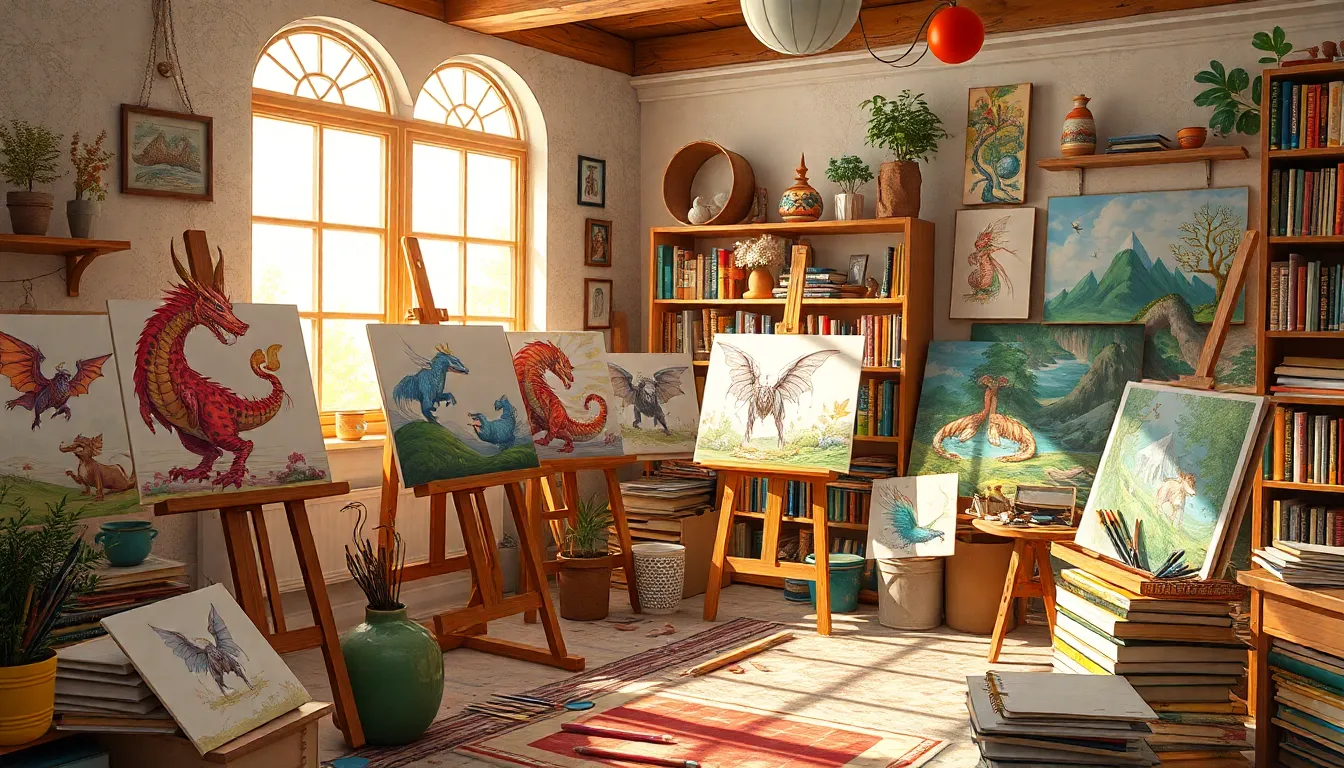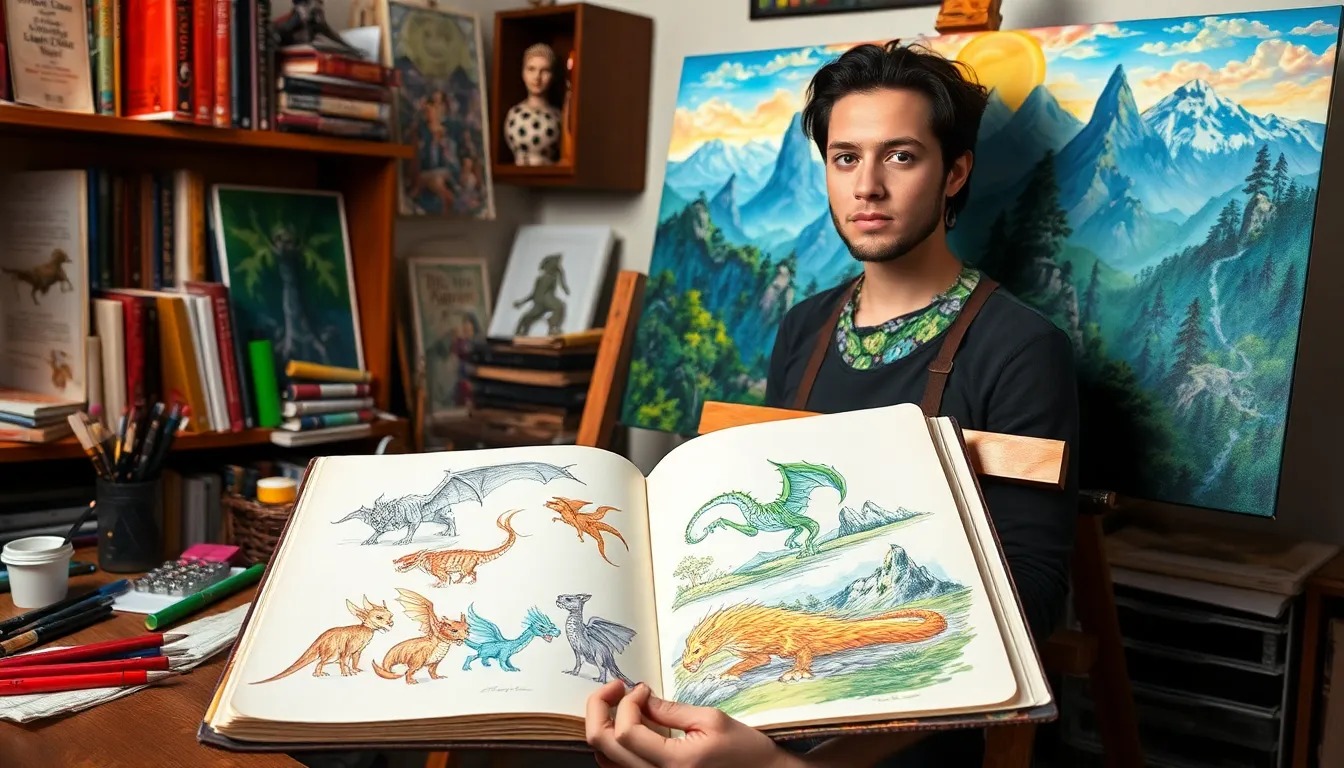In a world where dragons soar and wizards wield unimaginable power, fantasy inspiration fuels the imagination like a double shot of espresso on a Monday morning. Whether it’s the enchanting realms of Tolkien or the whimsical adventures of Lewis, fantasy has a magical way of sparking creativity. It invites dreamers to explore uncharted territories, where the only limit is their imagination—and maybe their ability to find a decent Wi-Fi signal.
But fantasy inspiration isn’t just for novelists or gamers. It seeps into art, fashion, and even your next dinner party theme. Who wouldn’t want to host a soirée where guests arrive as their favorite mythical creature? So buckle up and grab your quill; it’s time to dive into the fantastical world of inspiration that awaits just beyond the pages of a good book or the screen of a beloved film.
Fantasy Inspiration
Fantasy inspiration arises from the unique ability of imaginary worlds to spark creativity. Writers often draw on mythical elements to create rich narratives, while artists translate fantastical visions into visual masterpieces. Fantasy settings allow them to explore themes of heroism, adventure, and friendship through characters that resonate deeply with audiences.
Gamers immerse themselves in expansive universes, utilizing lore that enhances gameplay and storytelling. These interactive experiences cultivate a sense of wonder and escapism, encouraging gameplay that aligns with their unique imaginations. Fashion designers find inspiration in fantasy aesthetics, incorporating vibrant colors and ethereal designs that embody characters from beloved tales.
Iconic works from authors like Tolkien and Lewis illustrate the compelling nature of storytelling. Their creations transport readers to realms where anything is possible. Engaging with these narratives opens doors to new ideas and perspectives that enrich everyday life. The imaginative depth found in fantasy prompts individuals to think outside conventional boundaries and embrace their own creative potential.
Event planners also incorporate fantasy themes into their projects. From whimsical weddings to enchanting birthday parties, themed events captivate guests and create lasting memories. By embodying favorite mythical creatures, participants fully engage in the fantasy experience, making the event unforgettable.
Exploring this enchanting realm invites participants to recognize the significance of fantasy in their creative journeys. Individuals can discover limitless sources of inspiration, allowing them to transform their experiences and ideas into tangible expressions of art.
Sources of Fantasy Inspiration

Fantasy finds its roots in various sources that invigorate creativity and stimulate imagination. These sources serve as wellsprings of ideas for writers, artists, and creators across multiple disciplines.
Literature and Mythology
Literature and mythology function as significant pillars of fantasy inspiration. Classics by authors like J.R.R. Tolkien and C.S. Lewis provide rich narratives that transport readers into vibrant worlds. Greek and Norse myths introduce unique characters and epic tales, captivating audiences with their timeless themes. Many contemporary authors draw upon these ancient stories, weaving intricate plots and crafting relatable heroes. Festivals of folklore from different cultures also supply fresh perspectives and character archetypes. Engaging with these texts encourages deeper connections to mythology, creating endless storytelling possibilities.
Art and Film
Art and film play vital roles in shaping the fantasy genre. Iconic films like “The Lord of the Rings” and animated features such as “Spirited Away” showcase visually stunning worlds that ignite imagination. Artists like Brian Froud and Yoshitaka Amano illustrate fantastic creatures and landscapes, leading viewers into their dreamlike visions. Art movements such as surrealism and romanticism further expand the visual language surrounding fantasy. Cultivating inspiration from both contemporary and classic artworks allows creators to tap into diverse interpretations of fantasy, enriching their own artistic endeavors.
The Role of Nature in Fantasy Inspiration
Nature serves as a fundamental source of fantasy inspiration, fueling creativity through diverse landscapes and creatures.
Landscapes and Creatures
Landscapes capture the imagination with their vastness and beauty. Mountains, forests, and oceans shape vivid backdrops for fantastical tales. Writers often draw from real-world environments, transforming them into magical realms. Diverse climates, such as enchanted forests or arid deserts, create unique settings for adventures.
Creatures add depth to these worlds. Elves, dragons, and fairies often embody traits from nature. Each creature usually has its own backstory, intertwined with the environment it inhabits. By blending realism with fantasy elements, creators enrich narratives and engage audiences. Artists visualize these beings, bringing them to life on canvas. Nature’s influence becomes evident through distinct character designs and ecosystems, enhancing the overall fantasy experience.
Creating Unique Fantasy Worlds
Designing imaginative realms involves careful consideration of various elements. Worldbuilding requires a foundation that intertwines geography, culture, and history. Unique landscapes can inspire enchantment, drawing from mountains, rivers, and forests. Distinct cultures enrich the narrative, introducing diverse traditions, languages, and belief systems.
Incorporating magical elements enhances the setting. Magical systems, governed by rules, define how magic operates in the world. Creatures populate these realms, often mirroring characteristics found in nature. Writers frequently craft beings like elves, dragons, and fairies, giving them compelling backstories rooted in their environments.
Intertwined histories solidify the fantasy world. Events shape societies, influencing political structures and alliances. By creating engaging lore, storytellers immerse audiences deeper into the narrative. Historical conflicts or legendary heroes provide a backdrop that resonates, allowing readers to connect emotionally.
Incorporating relatable characters can also heighten engagement. Heroes possess traits that audiences find appealing, such as bravery and resilience. Villains often present moral complexities, exploring themes of power and redemption. Character arcs grow through interactions with the world, reflecting the impact of their environments.
Developing unique aesthetics further adds depth. Visual elements like architecture, fashion, and symbols create a cohesive atmosphere. For instance, vibrant colors and ethereal designs lend a dreamlike quality. Each component interrelates with others, forming a rich tapestry that invites exploration.
Engaging narratives arise from seamless world integration. As readers journey through these realms, they encounter challenges and triumphs alongside characters. Well-crafted settings and intricate lore provide the perfect backdrop for compelling storytelling, elevating both the narrative and the experience.
Conclusion
Fantasy serves as a wellspring of inspiration that transcends boundaries. It encourages creativity across various fields from writing and art to fashion and event planning. By immersing themselves in the enchanting worlds crafted by visionary authors and artists, individuals can unlock new ideas and perspectives.
Nature’s beauty and the rich tapestry of myths and legends continue to fuel the imagination, allowing creators to weave intricate narratives and designs. Embracing fantasy not only enhances artistic expression but also enriches everyday experiences. Whether through themed gatherings or personal projects, tapping into this magical realm can lead to transformative and unforgettable moments.

